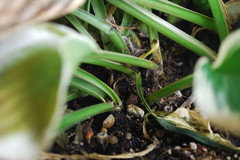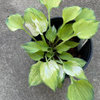Hot water nematode treatment
bkay2000
8 years ago
Featured Answer
Sort by:Oldest
Comments (32)
santamiller
8 years agolast modified: 8 years agosantamiller
8 years agoRelated Discussions
'Hot Water Treatment'
Comments (3)I don't have access to hot air! That sounds good, but I'll have to make do with the water treatment. I have found the successful method to heat the water!! I've wrapped my big stew pot in my electric heating pad and set it on "high". After leaving it for 8 hours (overnight), the temperature is ~117, so that should work. I'm buying a second thermometer today to confirm the temperature and will calibrate it. I think I could reduce the temperature a few degrees by loosening the wrap on one side. I will heat treat 2 bulbs on Wednesday (the 2 with the least damage to the neck) and will chip at least 1 other. The other suggestion was to soak one bulb in a systemic insecticide. If these pests aren't really bulb pests, but rather were just taking advantage of "too wet" bulbs...I am really hopeful that I'll salvage my "Gordie"! Thanks for the encouragement. K...See MoreHot water treatment complete & surprise
Comments (4)All my amies will be moved to the shelter of the enclosed porch for the storm. Recall that I did build there own little skylight roof to prevent them from getting doused with rain (this after we got 7 inches in 1 day). Darn old Ike looks like he's heading straight for us! I will most likely have the day off tomorrow to get all the plants situated and secure. Trimmed tree limbs with my "rent-a-husband" (the neighbor's hub) the other night, so we're in good shape there. Keep the Houston list members in your thoughts. Ike is a bad storm and is gaining strength! K...See MoreNematode Nirvana . . . Hot-climate deep sands
Comments (4)Here in the deep sands of NW Florida amending the soil with pine bark or compost and composted cowmanure,mushroom compost,(limestone if needed), Heavy mulch is recomended. Anything to help hold moisture and cool the soil and I understand the mulch and organics are good for earthworms and bad for nematodes. I have an LSU Purple I need to plant. I want to try grafting some weak growers onto LSU Purp root stock and see it helps. I believe their claim that it is Nematode 'Resistant' and every little bit of advantage helps. I'm losing a lot less trees now that I am basicly treating their planting hole allmost like I would a large pot. Our sand has nothing for the tree except drainage. Any moisture retention or food for the plant has to be provided by you. Good Luck R...See MoreNematodes and Soap/Mouthwash treatment
Comments (2)McT, I used that treatment last year as a preventative on all my hosta that did not have Nematodes. That was after I had spent a lot of time digging and heating and babying the 8 hosta that they had already gotten. I had NO nematodes this year. Of course I guess they could still show up, but this is the middle of September and I have no sign of them. I am continuing to treat the plants with this, about once every two weeks until frost. I'm with you, after last year I refuse to get stressed about plants, much as I enjoy them. This treatment is very easy and inexpensive. In the future if I find my gardens infested with the beasties after treating, I will be the first to admit that it didn't work and to warn others. Now if I can only find something to kill stinkbugs! We are attacked every time we go out into the yard. They hang on the screens and fly inside if we don't flick all of them off before we open the door. I don;t think I have ever been as disgusted by anything else! chris...See Morebkay2000
8 years agolast modified: 8 years agosantamiller
8 years agoPieter zone 7/8 B.C.
8 years agoBabka NorCal 9b
8 years agobkay2000
8 years agoPieter zone 7/8 B.C.
8 years agobkay2000
8 years agosantamiller
8 years agoirawon zone 5a Ottawa.ca
8 years agosantamiller
8 years agobkay2000
8 years agoDeb 215 SEWI5
8 years agoMadPlanter1 zone 5
8 years agobkay2000
8 years agozkathy z7a NC
8 years agobkay2000
8 years agosantamiller
8 years agobkay2000
8 years agolast modified: 8 years agoDeb 215 SEWI5
8 years agozkathy z7a NC
8 years agosantamiller
8 years agolast modified: 8 years agobkay2000
8 years agozkathy z7a NC
8 years agopuffdaddy
8 years agobkay2000
8 years agobragu_DSM 5
5 years agosunnywood4bChazyNY
5 years agobkay2000
5 years agobragu_DSM 5
5 years ago
Related Stories

KITCHEN DESIGNUsing White Marble: Hot Debate Over a Classic Beauty
Do you love perfection or patina? Here's how to see if marble's right for you
Full Story
COLORRoom of the Day: Deep Blue Proves a Hot Hue
Navy takes a New Jersey living room from dull to dashing in the flick of a paintbrush
Full Story
FIREPLACES12 Hot Ideas for Fireplace Facing
From traditional brick to industrial steel, there’s a fireplace cladding here to light up your design
Full Story
LIVING ROOMSDrop In on a Hot Comeback With a Sunken Living Room
Take the plunge into a new kind of practicality with an interior design feature that has a rich history
Full Story
GREENHot New Greens for Fall Decorating
Make your home ultrahappy with ultramarine or cheery with chartreuse, using the popular colors on walls, furniture or accessories this fall
Full Story
BASEMENTSThe Hot List: Beautified Basements
Nab function and styling ideas from the most popular basement photos on Houzz so far this year
Full Story
DECORATING GUIDESSo Your Style Is ... ‘Wet Hot American Summer’
11 ways to bring nostalgic early-’80s camp fun to your home
Full Story
BATHROOM DESIGNGreen and Clean: Sleek Water-Wise Bathroom Fixtures
By choosing ecofriendly faucets, showerheads and even toilets, you can save loads of water and money without sacrificing style
Full Story
LIFEThe Top 5 Ways to Save Water at Home
Get on the fast track to preserving a valuable resource and saving money too with these smart, effective strategies
Full Story
HEALTHY HOMEHow to Choose a Home Water Filtering System
Learn which water purification method is best for your house, from pitchers to whole-house setups
Full Story









bkay2000Original Author